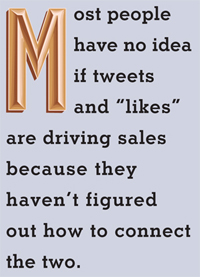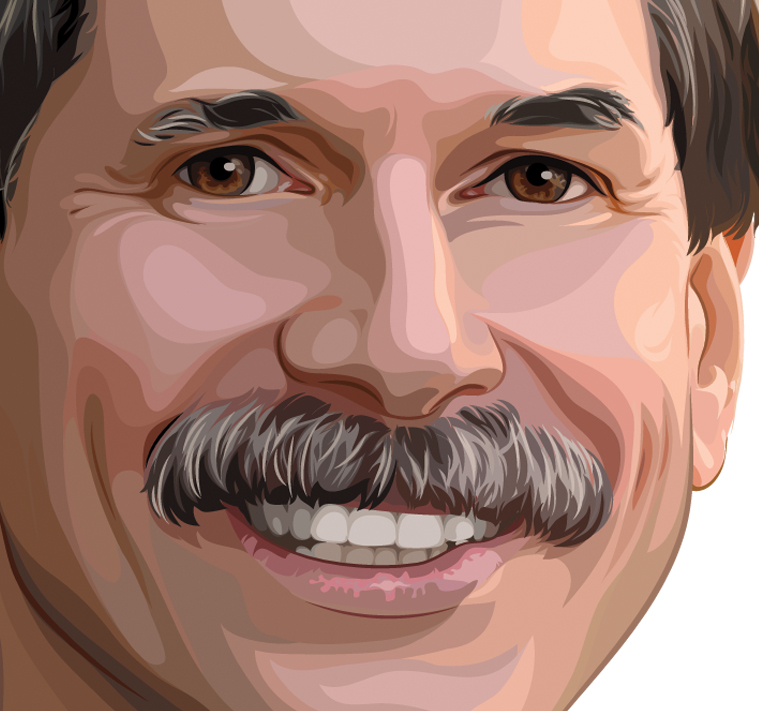Ed Keller
 Ed Keller is the CEO of the Keller Fay Group LLC, a research and consulting firm that specializes in word-of-mouth marketing research. He graduated magna cum laude from the University of Pennsylvania, and was the CEO of research firm RoperASW before founding Keller Fay. He cowrote "The Face-to-Face Book: Why Real Relationships Rule in a Digital Marketplace" with Brad Fay, and the book was recently awarded the 2013 Berry-AMA Book Prize by the American
Marketing Association Foundation. Keller is also a conference speaker at EXHIBITOR2014. In his session, "The Next Social Marketing Revolution," he reveals what drives today's social-media marketing, and shares how marketers can challenge their assumptions about consumer decision making.
Ed Keller is the CEO of the Keller Fay Group LLC, a research and consulting firm that specializes in word-of-mouth marketing research. He graduated magna cum laude from the University of Pennsylvania, and was the CEO of research firm RoperASW before founding Keller Fay. He cowrote "The Face-to-Face Book: Why Real Relationships Rule in a Digital Marketplace" with Brad Fay, and the book was recently awarded the 2013 Berry-AMA Book Prize by the American
Marketing Association Foundation. Keller is also a conference speaker at EXHIBITOR2014. In his session, "The Next Social Marketing Revolution," he reveals what drives today's social-media marketing, and shares how marketers can challenge their assumptions about consumer decision making.
|

iven the sheer number of people on Facebook, LinkedIn, and Twitter (the sites boast 1.2 billion, 230 million, and 259 million users, respectively), it's easy for marketers to fall into the trap that social media is a silver bullet for mass communication. After all, it generates 25 billion brand impressions each year. But there's another marketing medium with a far greater reach and a more impressive track record: real-life conversations.
According to Ed Keller, co-author of "The Face-to-Face Book: Why Real Relationships Rule in a Digital Marketplace," in-person communication nets 750 billion brand impressions every year – that's 300 percent more than tweets, posts, shares, "likes," etc. In this candid interview, Keller explains why people in general, and marketers in particular, shouldn't completely abandon face-to-face conversations in favor of social-media tools.
EXHIBITOR Magazine: It seems like a new book applauding social-media marketing hits the shelves every few weeks. How does your approach differ?
Ed Keller: My co-author Brad Fay and I believe that while the concept of social-media marketing makes an awful lot of sense and is powerful and important, the amount of attention it gets is disproportional to its size, scope, and influence. Consumers are social creatures, and even in today's digital era, most conversations take place face to face. That's the way it's been for thousands of years, and it's never going to change.
We believe that those face-to-face conversations are more likely to lead to credibility, especially when it comes to marketing word of mouth. Our research shows that they're also more persuasive than a tweet or Facebook post, and have a higher chance of resulting in some sort of action or even a purchase. These types of social conversations are the way that people make decisions, and they have a direct impact on sales.
That said, technology gives us a new way to communicate, but it shouldn't be at the expense of face-to-face communication. In truth, the primary channel that social media has displaced over the past few years is email communication. As a society, we've simply substituted one form of tech-driven communication with another, but real relationships still rule.

EM: How does that view translate to exhibit and event marketing?
EK: First and foremost, exhibits and events are all about gathering in person and networking with one another. While doing that, everyone is exchanging ideas, communicating emotions, and using both verbal and nonverbal cues to bolster the conversation. Some of that can be done via social media. But face-to-face events provide a highly valued opportunity for attendees to establish a much more personal rapport with exhibitors and even other attendees. A connection is created that can't be replicated by social media.
EM: So if in-person experiences can't be replaced by online conversations, how did social-media tools quickly gain so much traction in the exhibit and event industry?
EK: I think it comes down to people's fascination with shiny new toys. Companies are fearful of being left behind, so they jump on the newest, flashiest bandwagon without first devising a marketing strategy that embraces word of mouth, and then determining how best to drive brand advocacy. There's nothing wrong with bringing social media into the marketing equation. But there is something wrong with scribing more power to it than it has earned.
During the Great Recession, the exhibit and event industry billed social media and online tools as cost-effective alternatives to face-to-face interaction for those who didn't have the budget or resources to attend a trade show or event in person. That started an avalanche of interest, and I believe social media oversold its promise and people started to undervalue the opportunities afforded by attending live events and shows.
Make no mistake – a tweet or post is not the same experience as sharing information with someone in person, nor does it hold the same weight. Face to face is sometimes disregarded as dated or old school. But it's not some vestige of a bygone era. It is still the manner in which people prefer to communicate, even with all of the technology available.
 EM:
EM: Since social media isn't going anywhere, either, how do exhibit and event marketers determine the right balance between offline and online conversations for their programs?
EK: The biggest mistake I see exhibitors make is picking a social-media tool first, and then figuring out how they want to use it. I've heard "Oh, we need to tweet!" far too many times. My question is always "Why?" If your target audience isn't on Twitter day in and day out, it's probably not going to see the message.
We suggest a different approach. Just like any other marketing avenue, you need to start with your story. What's your message, and why should people care about it? Next, tap the right talkers (e.g., influencers, bloggers, brand ambassadors, etc.) that will share your story. Then, and only then, does it make sense to turn to the the channels those influencers use to communicate. Maybe it includes social media. Maybe it doesn't. and it's certain to include a whole host of other options, too. It's marketing 101, but the quick adoption of social media somehow led people to ignore the basics.
I think social-media tools should be used to complement face-to-face interactions. In fact, experience-driven word-of-mouth is the key to powerful social marketing. To drum up excitement for an exhibit program, you have to create live experiences that people can only get at the trade show. Don't put everything on a website – that negates any reason for someone to visit in person. Why should he or she give you the time of day at a show if all the information is readily available online? You need to create a reason for people to visit your booth, and then use social media to promote that reason. You need to craft powerful stories that are well told with drama and humor. Hint at the booth experience via social media, but don't give it all away. For example, you could tweet a special phrase or password, and then instruct trade show attendees to repeat that password in the booth to receive a prize.
At the end of day, people will share their experiences online and offline. That's the funny thing about people. We all want to have experiences, and we want to tell each other about those experiences. Social media is all about "I did this," "I went there." Well, that's what shows and events are all about, too. So there's a built-in symbiotic relationship if marketers would just spend a little more time strategizing their approach.
EM: Let's talk about metrics. Social-media statistics are readily available, and results seem almost instantaneous. Do you think companies get caught up in the numbers without assigning value to them?
EK: Absolutely. There is a huge digital footprint for social media. It's relatively easy to measure, and Facebook, Twitter, LinkedIn, etc. all pump out statistics. They don't do it nefariously; they just make the information readily available to anyone that's interested. People key in on that data without determining whether the marketing dollars they're investing today are netting a return. I'm not saying there is no return on investment to be had with social media, but most people have no idea if tweets and "likes" are driving sales because they haven't figured out how to connect the two – and few are willing to pay for the research to do so.
Companies with multimillion-dollar ad campaigns will happily tout the 1,000 "likes" about something they posted on Facebook. Is 1,000 a big number? Is it a big number when you're used to reaching millions through print and television advertising? Not really, but I guarantee that the people in charge of those social-media campaigns will be very quick to run to the bosses and say, "Hey look at what we got! A thousand!"
Read All About It
  "The Face-to-Face Book: Why Real
Relationships Rule
in a Digital Marketplace,"
outlines why
companies shouldn't
completely abandon
in-person conversations
in favor of digital
dialogue. Authors Ed Keller and Brad Fay
of the Keller Fay Group LLC use science,
measurement, and research to prove that
offline interaction is just as effective â?" if
not more so â?" than social media and
online communication.
Keller and Fay write, "We believe in a
marketplace that is highly social, but not
because of peculiar platforms or technologies.
The most successful businesses in
the future will be the ones that embrace
a model that puts people ... at the center
of products, campaigns, and market strategies.
They will recognize that people
will have a far greater impact on each
other than we previously realized, and
that consumers are not just a collection
of individuals."
To buy a copy of the "The Face-to-Face
Book," click here. "The Face-to-Face Book: Why Real
Relationships Rule
in a Digital Marketplace,"
outlines why
companies shouldn't
completely abandon
in-person conversations
in favor of digital
dialogue. Authors Ed Keller and Brad Fay
of the Keller Fay Group LLC use science,
measurement, and research to prove that
offline interaction is just as effective â?" if
not more so â?" than social media and
online communication.
Keller and Fay write, "We believe in a
marketplace that is highly social, but not
because of peculiar platforms or technologies.
The most successful businesses in
the future will be the ones that embrace
a model that puts people ... at the center
of products, campaigns, and market strategies.
They will recognize that people
will have a far greater impact on each
other than we previously realized, and
that consumers are not just a collection
of individuals."
To buy a copy of the "The Face-to-Face
Book," click here. |
Granted, results and statistics are available for face-to-face interactions, too. If we look at a measure of annual brand impressions through word of mouth, social media nets 25 billion per year. That's a huge number, right? When you look at offline conversations, those impressions jump by a factor of 30 to 750 billion. So why do people think online communication is better? Because they lack perspective. It's not better – nor has it replaced people's interest in face-to-face interaction – it just gets more attention.
There are a handful of breakout social-media campaigns. One of my favorites is last year's Oreo tweet during the Super Bowl. If you recall, there was a power outage in the stadium and within minutes, Oreo tweeted an image of its cookie and the text, "You can still dunk in the dark." It was social-media marketing at its best.
But for every Oreo success, there are thousands of tweets that no one cares about. Our culture tends to zero in on the stars and successes, thinking we can achieve the same results. The marketing odds are against you.
EM: Is there a marketing light at the end of the social-media tunnel?
EK: The most important thing to remember about social media is that it should be used in proportion with offline communication. Face-to-face conversations always work, even if you can't track it as easily as the number of shares and "likes." Supplement those conversations with thoughtful social-media campaigns. I urge you to invest in and learn about social media and how it works. Embrace it and get better at it. But don't get rid of the core that makes it all work: in-person interaction. It's not going back to the basics, it's going into the future of marketing with the basics.











